

Fan fotos: SoCal doorslammers
Long before there were nitro Funny Cars and even what we know as Top Fuel dragsters, door cars and roadsters often attracted the same fanatic love to which we now assign the nitro cars. I know that I have a fuel-racing mentality – particularly for 1970s-era Funny Cars -- but I also love a good doorslammer. So, apparently, does Robert Nielsen, who submitted the great photos below, with nary a digger or flopper in sight, and provided informative explanations for each.
For fans and racers who attended the digs, it's not always the showstoppers they remember but also some of the other cars, and I'm sure that anyone who frequented SoCal tracks will recognize some of these lesser-spotlighted but nonetheless interesting and nostalgic machines.
"I have more than 1,000 images of cars from Lions, OCIR, Irwindale, San Fernando, and other tracks in SoCal, Nor Cal, and Arizona," said Nielsen. "Most of these images were taken on occasions when I was not running my car but still traveled to the races to help friends with their cars and took along my 35mm Nikon FTN camera. For the most part, the photos that I took were of cars that were either friends' or cars I raced against. While I do have some photos of dragsters, Funny Cars, and Pro Stock, these are definitely only a very small portion of the images that I have. While I do not consider myself a photographer – I am a picture taker, the difference being a photographer knows what he is doing, and I just take a LOT of photos, and some turn out OK."
These definitely turned out OK, Robert. Thanks for sharing. The quoted parts below are Robert's notes for each photo.
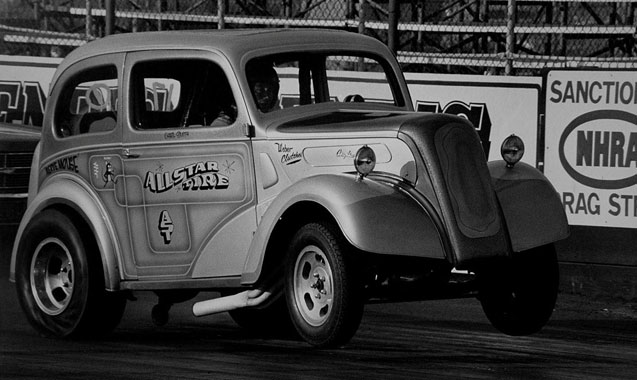 |
"Here's Carl Smith’s small-block Chevrolet-powered All Star Tire Anglia as he makes another typical wheels-up launch off the line at Lions Drag Strip. I am not sure of the exact date of this photo, but it must be 1971 or 1972 as there is an NHRA sign in the background (prior to this time, Lions was an AHRA track). This car was an extremely hard-running bracket car and was at Lions every Saturday night and Sunday afternoon, almost without exception! I, too, spent a lot of time there and occasionally had my Nikon FTN camera with a 50-300mm zoom lens with me when my car was undergoing some periodic maintenance or update. The things that I have always liked about this photo are the front end being carried in the air, the rear tires slightly distorted from the forward launch thrust, and one can almost see the cool, calm, relaxed expression on Carl’s face as he drives his car down the track."
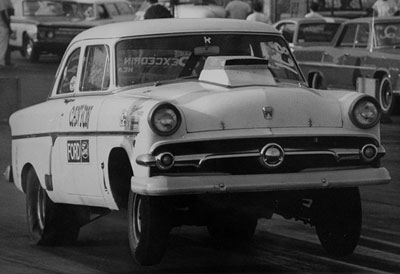 |
"This is Ted Wells' 1954 Ford. This car was unique. I raced with Ted from about 1969 until 1974. Ted was the shop foreman at Larry Orfia's Valley Head Service (in Tarzana, Calif., two doors down from Frank Huszar's Race Car Specialties shop). I spent a lot of time hanging around VHS and RCS in those days, much to the detriment of my college education. Ted’s car was originally powered by a 352-cubic-inch big-block Ford. This was later changed to a destroked 427 big-block Ford; actual displacement was 396 cubic inches. Ted was a master machinist and fabricated a lot of the parts on this car. He fabricated a custom aluminum tunnel ram intake manifold simply because at the time there were none available for a big-block Ford and partly because he liked a challenge. He also molded the entire fiberglass front end himself. This car weighed in excess of 3,800 pounds. It would launch so hard that it literally would pull the pinion carrier out of the third member on the 9-inch Ford rear end. To fix this problem, rather than changing to a Dana rear end (which was in vogue at that time), Ted fabricated a custom third member out of 4130 steel plate that he welded and machined himself as there were not any other options available to be purchased if you wanted to run a 9-inch Ford rear end back then. He also ran a Ford top loader 4-speed transmission that he had modified to the point where he NEVER missed a gear-change shift! This car ran consistently 10.70s, which was very fast for that era. In 1974, Ted was working on building a Super Stock 427 Fairlane, although I am not sure if he ever completed this project as he moved to Wichita, Kan., and I lost contact with him."
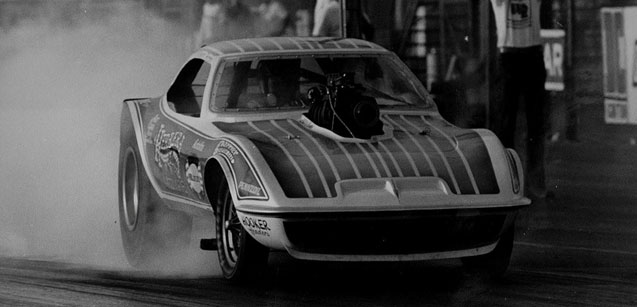 |
Nielsen knows that I have a soft spot for supercharged Opels after my short stint behind the wheel of Frank and Linda Mazi's BB/A in 1984, so he included this great shot of the Herrera and Sons AA/GS Opel, taken during one of the Sunday events at Lions. Bitchin'.
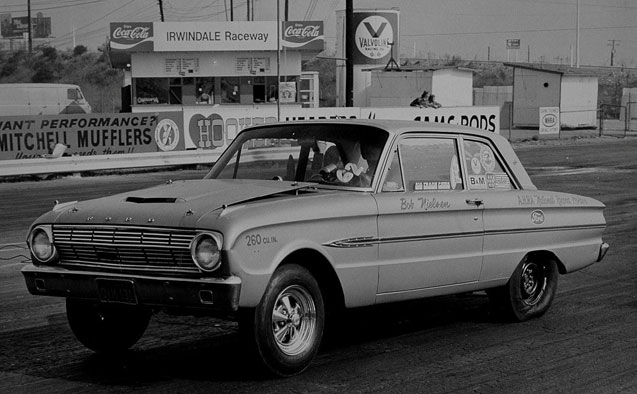 |
Nielsen could not resist including his own first car in this piece; of course, the photo was not taken by him (that would be some feat, eh?). I love the pic for its snapshot-in-time view of the Irwindale starting line and snack bar. Although the track is long gone, the road in the background that goes over the 210 freeway still pretty much looks the same, and I shed a tear every time I drive on it. Said Nielsen, "My car first car was a 1963 Ford Falcon powered by a 260-cubic-inch small-block Ford engine. It had a B&M Hydromatic transmission. This transmission had a 4.05 1st gear, and coupled with the 5.43 rear end, it launched real well and would rev way past 8 grand if I was not quick on the 1-2 shift (this was before I installed a rev limiter that I designed and built myself). I also modified the distributor so that it would retard the timing when I shifted into high gear. This car was much more competitive in the AHRA than in the NHRA as I held a number of AHRA national records, including the H/Stock Automatic record at 12.97 seconds and 109.35 mph in 1969. I did mange to hold the Irwindale D/Modified Production class record, which allowed me to participate in their annual Grand Prix race, and the OCIR D/Modified Production class record. I also held track class records at San Fernando Raceway, Beeline (Phoenix), and Fremont."
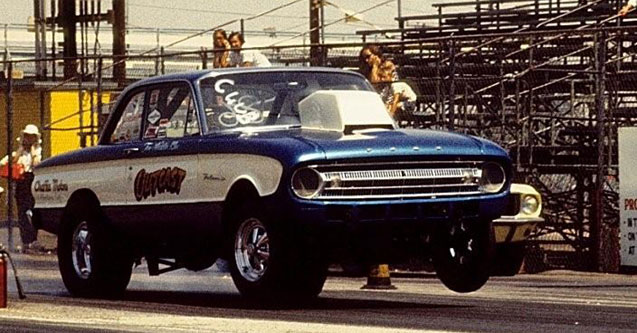 |
"Tom Nicklin & Sons Outcast. Being a Ford racer, I was always somewhat partial to other Fords. Anyone could make a Chevrolet run, but it took real heart and dedication to make a Ford run (some might add stupidity to that also). This car had a fuel-injected big-block Ford in it; I think it was a 427, but I might be wrong. This was another of the many cars that was at Lions every Saturday night and Sunday afternoon."
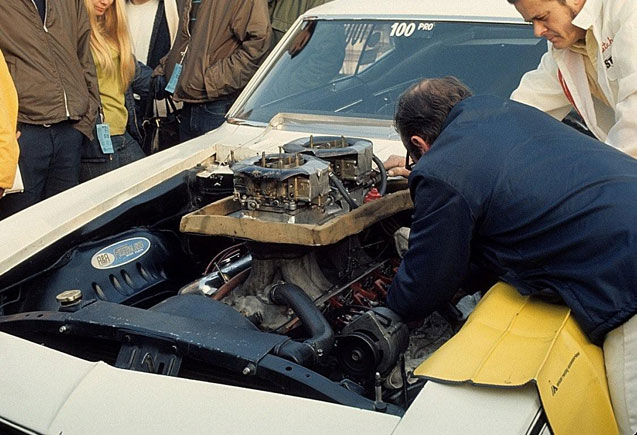 |
Nielsen took this photo in November 1970 in the pits at the inaugural NHRA Supernationals at Ontario Motor Speedway of Bill “Grumpy” Jenkins adjusting the valve lash on his Pro Stock Camaro. He said, "What I find rather unique about this photo is the total lack of ‘secrecy’ that is displayed by Pro Stock teams today. No trying to hide anything that is ‘under the hood’ that might give up some advantage you may have over the competition, unlike Bob Glidden when he crashed his Thunderbird and the first thing he did when he crawled out was take his jacket off and cover up the intake. I also like the duct tape being used to hold the beat-up plates on top of the carburetors. And if one looks closely at the interior, you can see that there are still some of the original factory door panels and interior parts in place – unlike today’s hand-fabricated from-scratch Pro Stock cars where nothing is stock anymore!"
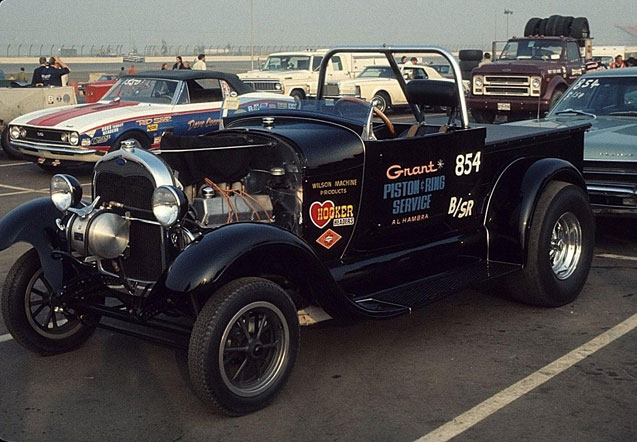 |
Another pit shot from the 1970 Supernationals; this one shows Jim Stevens’ B/Street Roadster, which took Modified honors at the event. The car was powered by a fuel-injected Ford Boss 302. Stevens was a full-time Los Angeles County firefighter.
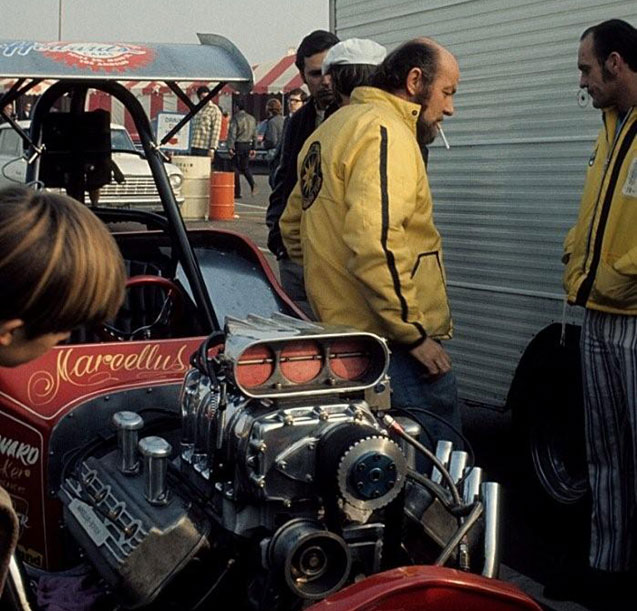 |
And yet another pit shot from Ontario, this time of the famed Marcellus & Borsch Winged Express AA/Fuel Altered. That's the wild man himself, "Wild Willie" Borsch, having a smoke. "I loved – and still do love – the fuel altereds," said Nielsen. "One never knew exactly which direction these short-wheelbased cars might actually go. They definitely were exciting to watch run and I suspect even more exciting to drive!"
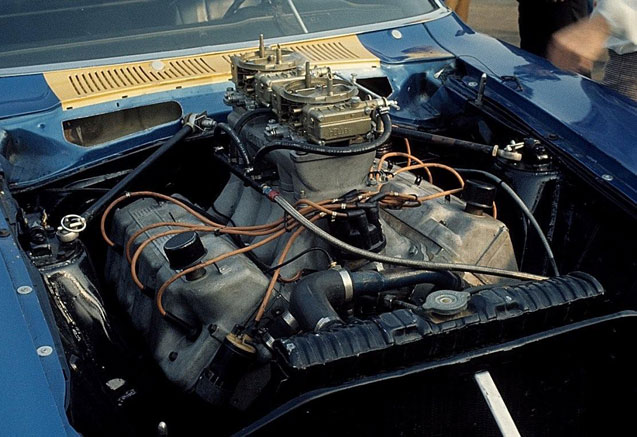 |
Wally Parks always told me that everyone loves a good engine shot, and this one will make a believer out of you. Again from the 1970 Supernationals, this is the Boss 429 Ford Maverick in Dick Brannan’s Pro Stocker. "The Holley carburetors on this engine setup are inline – not crosswise – making them really difficult to rejet!" pointed out Nielsen. "Also, the magnesium valve covers are starting to look like they could have used a little TLC." Quite a far cry from today's Pro Stock engines for sure!
OK, race fans, that's it for the day. I hope you enjoyed the little non-nitro side trip down Memory Lane. I'm sure there are dozens of Lions denizens out there who fondly remember these cars, and I think they make for an interesting collection of early iron.
See ya next week.



















































